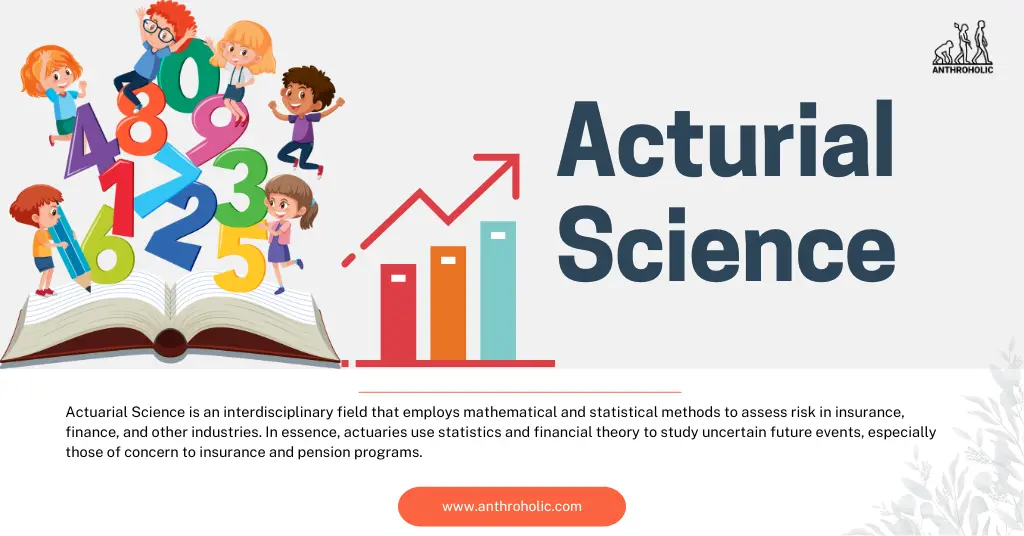AI Answer Evaluation Platform Live Now. Try Free Answer Evaluation Now
Acturial Science
Actuarial Science is an interdisciplinary field that employs mathematical and statistical methods to assess risk in insurance, finance, and other industries. In essence, actuaries use statistics and financial theory to study uncertain future events, especially those of concern to insurance and pension programs.

History of Actuarial Science
Actuarial Science traces its origins to the 17th century, when mathematics, particularly probability theory, started to be used for valuing life insurance and annuities. The Actuarial Society of America, the first actuarial organization in the world, was established in 1889 [1].
Fields of Actuarial Science
Actuarial Science is applied in numerous sectors:
- Insurance: This is the most well-known application of Actuarial Science, specifically in life, health, and general insurance.
- Pensions: Actuaries assess the financial impact of retirement plans and pensions.
- Finance and Investment: Actuaries are involved in managing and advising on investments.
- Enterprise Risk Management: Actuaries help businesses identify, manage, and mitigate risk [2].
Core Principles of Actuarial Science
Actuarial Science operates on several fundamental principles:
- Mathematics and Statistics: Actuaries use advanced statistical and mathematical techniques to predict uncertain future events.
- Financial Theory: This allows actuaries to evaluate the likelihood of an event occurring and its financial implications.
- Computer Science: Actuaries leverage computing power for complex numerical calculations and simulations.
- Economics: Actuaries must understand economic trends and their impact on their risk assessments.
Major Techniques in Actuarial Science
| Technique | Description |
|---|---|
| Survival Models | These assess the likelihood of survival for different groups. |
| Credibility Theory | This helps actuaries determine the reliability of past data. |
| Loss Reserving | This estimates future claim liabilities. |
| Ruin Theory | This calculates the risk of a company going bankrupt [3]. |
The Actuarial Profession
Actuaries are professionals who apply their skills in various sectors, primarily insurance and pensions. They are responsible for calculating premiums, ensuring solvency, developing investment strategies, and assessing overall risk. In addition to the technical aspects, actuaries also need to adhere to strict professional and ethical standards.
Education and Certification
Most actuaries hold a degree in mathematics, statistics, or a related field. After graduation, they typically undergo a series of rigorous examinations to become certified professionals. In the United States, actuaries are certified by either the Society of Actuaries (SOA) or the Casualty Actuarial Society (CAS) [4].
Career Prospects
The demand for actuaries is high, with industries such as insurance, consulting, and government seeking their expertise. The U.S. Bureau of Labor Statistics predicts a 18% increase in actuary employment from 2020 to 2030, much faster than the average for all occupations [5].
Challenges and Future Directions
With increasing computational power and advanced data analytics techniques, Actuarial Science faces both opportunities and challenges:
- Big Data and AI: Actuaries can use these to improve risk predictions but must also consider ethical implications and data privacy issues.
- Climate Change: Climate risk is an emerging field for actuaries, requiring innovative risk assessment methods.
- Regulatory Changes: Changes in financial regulation can significantly impact actuarial work, necessitating continuous learning and adaptation.
The Actuarial Process
The fundamental process of actuarial science involves a series of sequential steps:
- Problem Definition: Clearly stating the problem to be solved, usually related to financial risk measurement.
- Model Construction: Building a mathematical model to represent the problem.
- Data Collection: Gathering the necessary data to feed into the model.
- Solution: Solving the model using data analysis, statistics, and mathematics.
- Interpretation: Interpreting the results in a business context and suggesting recommendations.
- Communication: Effectively communicating the results to non-technical stakeholders.
Tools and Technologies
Actuaries use an array of software and programming languages to aid in their complex calculations:
- Excel: Essential for performing basic to intermediate data analysis and calculations.
- SQL: Used to handle, extract, and analyze data from databases.
- R and Python: These programming languages are useful for advanced data analysis, statistical modeling, and machine learning.
- Actuarial Software: Software like GGY AXIS and Prophet are tailored for actuarial computations and risk modeling [6].
Actuarial Science’s Social Impact
Actuarial science isn’t solely about number-crunching. It has a significant social impact. Actuaries safeguard financial systems by ensuring that insurance companies are solvent and pension funds can meet their obligations. They protect individuals and families from financial hardships and ensure societies can function and thrive [7].
Actuarial Science vs. Data Science
There’s a rising discussion on the distinction between actuarial science and data science, two fields steeped in mathematics and statistics. Key differences are:
- Problem Orientation: Actuaries focus on financial risk, while data scientists can work on a wider range of problems.
- Regulation: Actuarial work is highly regulated, which is less so for data science.
- Certification: Actuaries require professional certification, but there’s no standard credentialing for data scientists.
Despite differences, these fields overlap, and the integration of data science techniques can enrich actuarial work.
In conclusion, Actuarial Science is an evolving field with vast applications. Its blend of mathematical rigor, financial expertise, and practical knowledge ensures it will remain indispensable in our increasingly data-driven world.
References
[1] Dickson, D.C.M., Hardy, M.R., & Waters, H.R. (2013). Actuarial Mathematics for Life Contingent Risks. Cambridge: Cambridge University Press.
[2] Panjer, H. H. (2006). Actuarial Mathematics and Life-Table Statistics. Maryland: University of Maryland.
[3] Sundt, B. (2007). An Introduction to the Theory of Ruin Processes. Zürich: ETH Zürich.
[4] Actuarial Examinations. (n.d.). Retrieved from Society of Actuaries (SOA) website.
[5] Bureau of Labor Statistics, U.S. Department of Labor, Occupational Outlook Handbook, Actuaries. (2023).
[6] Actuarial Software Tools. (n.d.). Retrieved from Society of Actuaries (SOA) website.
[7] Foroughi, K. (2020). Actuarial Science: Theory and Methodology. Singapore: World Scientific Publishing Co Pte Ltd.




